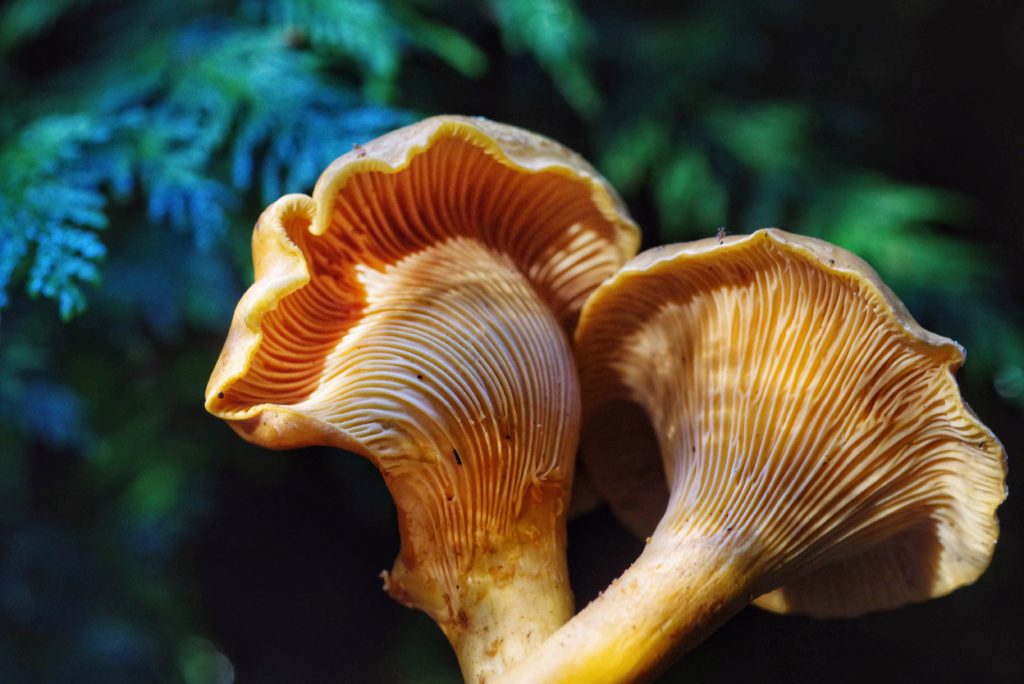
Compiled from the Salem Statesman Journal and YachatsNews.com
It’s mushroom season on the Oregon coast.
The prize of the local fungi group is the Pacific golden chanterelle, which was declared Oregon’s official state mushroom in 1999 and begins popping up shortly after fall rains begin.
But, many people don’t know that the chanterelle season starts way before the rains, says Liz Byrd of Yachats, an avid mushroom gatherer.
That’s because chanterelles are a mycorrhizal species found growing in forests with their host trees of Sitka spruce, Douglas fir and Western Hemlock. They often grow very close to the roots of the host tree, Byrd says, and get a lot of their moisture directly from the tree, which is why they can appear well before any rains.
The first chanterelle to appear is known as the Summer or Rainbow chanterelle.
They are a small and chunky chanterelle that first appear in July, in mature spruce and fir forests, Byrd says. The cap is more orange than the later and bigger chanterelles and can even have pink or white tones in it, hence the name “Rainbow” chanterelle. The underside of the cap is often a very brilliant dark yellow.
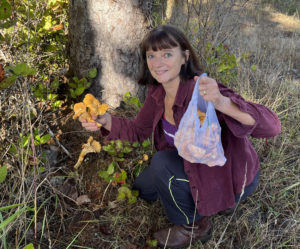
Summer chanterelles tend to thrive anywhere there is extra moisture, such as close to ocean where sea fogs settle, or in a river canyon where the water vapor rises up. Byrd said many people don’t notice them because they start off so small, almost like a splash of small round creamy pinheads on a mossy bank.
Next in the season come the bigger chanterelles, the Pacific chanterelle and Cascade chanterelle. These varieties do need rain to fruit in large numbers, and they are easier to see in the forest.
These are only just starting to appear, Byrd said. The Pacific chanterelle has a uniform golden yellow color on cap and underside and grows far above the duff, making it easier to spot. The Cascade chanterelle has a bright yellow cap with a whiter underside and stem and is often found in a big cluster which is very exciting to find.
Once there have been a bit of rain, the Pacific and Cascade chanterelles become the most abundant in the forest.
“They’re easy to find, they’re distinctive and very hard to mix up with other mushrooms,” Matthew Kilger, a longtime mycologist, forager and owner of Eating Oregon, told the Salem Statesman-Journal. “They have a great texture and flavor. It’s a nice starter mushroom. They’re also usually pretty clean and bug free, which is a luxury. Chanterelles are probably the most notable of Pacific Northwest mushrooms.”
The Coast Range and the Siuslaw National Forest are not only a hotspot for perfect chanterelle conditions, but also has a wide range of roads and access points to make for easy walking and hunting.
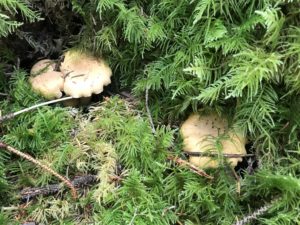
Like most mushrooms, chanterelles tend to avoid areas that are either too dry or too bright, opting instead for moister, canopied forests that provide filtered light and shade for fungus to thrive. Chanterelles thrive in older forests or areas heavily populated with coniferous trees after a rainfall.
It’s often said that chanterelles like to grow in “veins” or groups together when they fruit. If you found one, odds are, there are more hiding not far away.
A great place to start is by looking at a good map and selecting a forest road to drive up until you’re in mushroom territory. The Siuslaw National Forest provides two maps, one for the Central Coastal District and one for the Hebo District, to provide both inspiration for the journey and confirmation that you’re hunting in the right place.
If you’re feeling uneasy about heading straight into the unmaintained woods, you can also opt to forage on a hiking trail. Lightly used hiking or walking trails that traverse through forest lands are a great way to start to train your eye for mushrooms without needing a stellar sense of direction.
Keep your eyes peeled for the golden color of chanterelles on your walk, or practice taking a few steps off trail to peruse before connecting with the path again.
How to identify a chanterelle
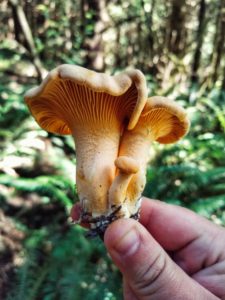
Part of the reason chanterelles are so popular is due to the easy process of identification. There are two common lookalikes, the jack o’ lantern mushroom and the wooly chanterelle, neither of which are deadly – just a recipe for a stomachache. However, once you understand the key characteristics of true chanterelles, even a beginner will easily be able to tell the difference.
Here are the basic identification tools to confirm that you’re in possession of a chanterelle:
- Chanterelles should be some shade of yellow or gold on the outside, and pure white on the inside;
- The gills underneath the cap of the chanterelle are “false” gills, sometimes referred to as veins. The gills are forked and folded amongst each other, rather than running in straight lines, and cannot be separated from the cap without tearing the mushroom;
- The stalk of the chanterelle is solid, not hollow;
- When separating the chanterelle, the “meat” of the mushroom will peel, almost like string cheese.
Know the rules
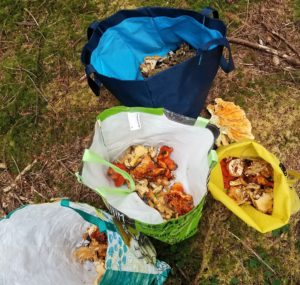
Because they grow in reoccurring colonies, chanterelle spots are beloved for their consistency, and also heavily guarded for that reason. A prized chanterelle spot can, in theory, produce a beautiful bounty year after year.
Mushroom hunting occasionally requires permits depending on what area you are foraging in, and it’s important to be well-versed on the rules. Knowing when, where and how you’re allowed to harvest in any given forest will not only keep you and the spaces safe, but also help to avoid fines of upwards of $5,000.
Always check with local rangers when possible prior to foraging to get the most up to date rulings and area closures. Foraging in off-limit areas, such as locations of fire closures or private properties, is not allowed.
There is no harvesting allowed of mushrooms on national parks or national monuments in Oregon.
State forests and parks: When foraging in state forestland no permit is required for personal use, up to 1 gallon or less per vehicle. When inside Oregon state parks and recreation areas, the limit for mushroom harvest increases to 5 gallons a day per person and includes other edibles such as berries and fruits.
U.S. Forest Service lands: When foraging on Forest Service land anyone can harvest one gallon of chanterelle mushrooms per day without a permit. If you plan on collecting more than a gallon per person, a permit is required. Permits can be obtained by anyone 18 and older from any district office in the area you plan to forage in. They are $2 a day with a minimum of 10 days ($20 for a 10-day pass) or $100 for a full calendar year. Harvesting mushrooms in more sensitive spaces such as botanical, research or scenic areas is not allowed. Rules for wilderness areas vary depending on the forest, so call ahead.
Bureau of Land Management: Individuals may harvest up to 1 gallon of edible mushrooms per person per day on land managed by BLM, no permit required.
Cooking and eating chanterelles
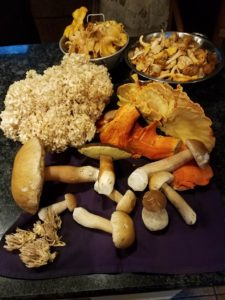
Chanterelles may be popular for their prolific appearances in the woods, but they’re also renowned for being just straight up delicious. Often described as both fruity and peppery in flavor with a “melt in your mouth” consistency, the meaty texture of chanterelles makes for an excellent addition to dozens of culinary ventures.
When preparing your chanterelles, washing them with cold water and a gentle toothbrush is often the best method for a deep clean that preserves the structure of the mushroom.
If you aren’t planning on cooking them immediately, however, do not get your chanterelles wet. Store fresh chanterelles in a paper bag in the refrigerator for up to 10 days before rinsing and cooking.
Finally, if you have enough chanterelles to want to save them for the future, there are a few options for long-term storage — with the knowledge that they are arguably best when fresh, no matter the method.
Because they are already a fragile mushroom, drying doesn’t work well for chanterelles, as they lose most of their flavor and crumble apart when dehydrated. Chanterelles are best preserved either frozen or pickled, after being lightly cooked beforehand via a dry sauté or steaming.
Liz Byrd’s dos and don’ts
- Do look in mature forests, especially in less visited areas;
- Do learn about toxic look-alikes; try getting the small handbook “All that the Rain Promises” by David Arora;
- Do slow down. Once you have found a chanterelle, look around carefully. You will very often find more close by;
- Do collect and look for identifying characteristics such as color, shape, size and smell prior to eating. Learn how to do a spore print. Consult with an expert and do not rely on identification from social media;
- Do a preliminary cleaning out in the field, the mushrooms will hold up much better;
- Don’t assume that all the mushrooms in an area are the same mushroom. Often poisonous mushrooms grow right next to choice edibles. Carefully check each one, and again when you are cleaning them. Sometimes people go into a ‘mushroom mania’ when they find a lot and that’s when mistakes can be made;
- Don’t give up! Sometimes it takes many excursions to find a good spot.
— Much of this story was compiled from the Sept. 19, 2022 edition of the Salem Statesman-Journal



